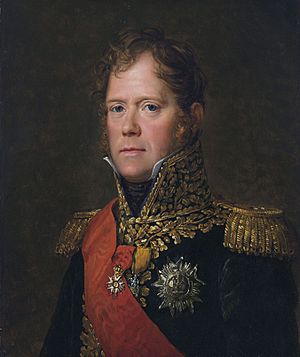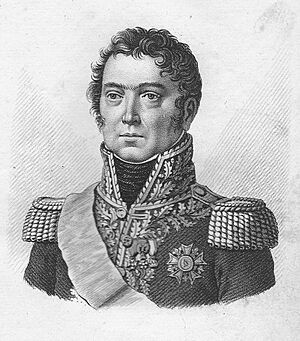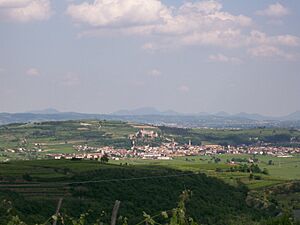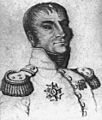Pierre-Louis Binet de Marcognet facts for kids
Quick facts for kids
Pierre-Louis Binet de Marcognet
|
|
|---|---|
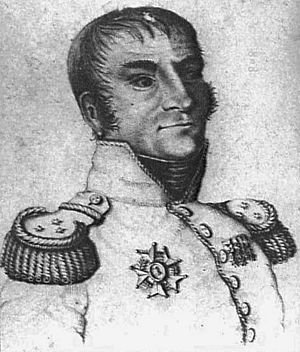
General of Division Pierre-Louis Binet de Marcognet
|
|
| Born | 14 November 1765 Croix-Chapeau, Saintonge, France |
| Died | 19 December 1854 (aged 89) Paris, France |
| Allegiance | |
| Service/ |
Infantry |
| Years of service | 1781–1832 |
| Rank | General of Division |
| Battles/wars | American Revolutionary War French Revolutionary Wars Napoleonic Wars |
| Awards | Légion d'Honneur Order of Saint Louis Order of the Iron Crown |
| Other work | Baron of the Empire |
Pierre-Louis Binet de Marcognet (born November 14, 1765 – died December 19, 1854) was a French general. He joined the French army in 1781 as a young officer. He fought in many important wars. These included the American Revolutionary War, the French Revolutionary Wars, and the Napoleonic Wars.
During his long career, Marcognet was wounded several times. He was even captured once. He rose through the ranks to become a general officer. He led troops in many famous battles, such as Hohenlinden and Waterloo. His name is honored on the Arc de Triomphe in Paris.
Contents
Early Life and the Revolution
Pierre-Louis Binet de Marcognet was born on November 14, 1765. His hometown was Croix-Chapeau in France. His family was noble, which meant they had a high social rank.
He joined the army in 1781. He served as a cadet in the Bourbonnais Infantry Regiment. From 1781 to 1783, he fought in the American Revolutionary War. He became a captain in 1792. He then joined the Army of the Rhine. This was at the start of the War of the First Coalition.
Marcognet was wounded in battle on September 14, 1793. This happened near the Lauter River. He was wounded again in November at the Second Battle of Wissembourg.
In December 1793, Marcognet was removed from the army. This was because he was from a noble family. At that time, noble people were often seen as enemies of the French Revolution. His family faced many difficulties during this period.
He was allowed back into the army in July 1795. He continued his service as a captain.
Battles and Promotions
In August 1795, Marcognet moved to the 10th Light Infantry Demi-Brigade. He fought under General Jean Victor Marie Moreau at the Battle of Ettlingen in July 1796. He was promoted to major the next day.
He was wounded again at the Battle of Biberach in October. Later, he was shot in the right arm during the Siege of Kehl.
Marcognet was promoted to colonel in June 1800. He led the 108th Line Infantry Demi-Brigade. At the Battle of Hohenlinden on December 3, 1800, his unit was in heavy fighting. His troops fought bravely against a larger enemy force. Despite being outnumbered, he held his ground. However, enemy soldiers secretly attacked his flank. Marcognet was wounded and captured during this battle.
Other generals praised Marcognet for his bravery and skill. He was promoted to general of brigade in August 1803.
Napoleonic Wars and Campaigns
Marcognet became a member of the Légion d'Honneur in 1804. He received the cross of the Légion d'Honneur from Emperor Napoleon in 1805.
Fighting in Central Europe
In the War of the Third Coalition, Marcognet commanded a brigade. It was part of Marshal Michel Ney's VI Corps. He led his troops at the Battle of Günzburg in October 1805. His soldiers captured enemy troops and cannons. He also fought at the Battle of Elchingen and Scharnitz that year.
During the War of the Fourth Coalition (1806-1807), Marcognet continued to lead his brigade. He fought at the Battle of Jena in 1806. He also took part in the Siege of Magdeburg. In 1807, he was at the Battle of Eylau.
He fought bravely at the Battle of Guttstadt-Deppen in June 1807. Here, Ney's smaller army skillfully fought against a much larger Russian force. Marcognet also participated in the Battle of Friedland later that month.
Campaigns in Spain and Portugal
In 1808, Napoleon gave Marcognet the title of Baron of the Empire. By 1809, he was with Ney's corps in Spain. They were fighting in the Peninsular War.
He fought at the Battle of Tamames in October 1809. His troops faced a strong Spanish army. The French attack faced heavy fire and had to retreat. Later, Marcognet's corps helped defeat the Spanish army at the Battle of Alba de Tormes in November.
Marcognet also led a brigade during the Siege of Ciudad Rodrigo and the Siege of Almeida in 1810.
In September 1810, Marcognet led his brigade in Marshal André Masséna's invasion of Portugal. His division suffered many losses at the Battle of Bussaco in September. During the retreat from Portugal in 1811, his brigade fought in several rear guard actions. These included battles at Casal Novo. He also led his men at the Battle of Fuentes de Onoro.
On August 6, 1811, Marcognet was promoted to general of division.
Later Years and Waterloo
After Napoleon's difficult campaign in Russia in 1812, Marcognet took command of the 48th Division in Italy. This was part of a new army formed under Napoleon's step-son, Eugène de Beauharnais.
Battles in Italy
When the Austrian Empire declared war in August 1813, Marcognet's division defended Italy. He fought in the Battle of Caldiero in November 1813. His division attacked the Austrian center, helping the French win the day.
In December, Marcognet's division was sent to defend the Lower Adige River. He attacked Austrian forces at Boara Pisani. After some initial success, the French were pushed back.
Marcognet also led his division at the Battle of the Mincio River in February 1814. This was a confused battle where both sides fought hard. The French and Austrians both suffered many losses.
After the fighting in Italy, Marcognet was awarded the Order of the Iron Crown. He was taken off active service for a time. King Louis XVIII of France honored him with the Order of Saint Louis and made him a Grand Officer of the Légion d'Honneur.
The Battle of Waterloo

At the famous Battle of Waterloo on June 18, 1815, Marcognet commanded the 3rd Division. It was part of Jean-Baptiste Drouet, Comte d'Erlon's I Corps. His division had about 4,200 soldiers. They were placed on the right side of the French line.
During the battle, Marcognet's division surged forward. They attacked the British and Netherlands troops. His soldiers fired a powerful volley, causing heavy losses to the enemy. The French shouted "Victory!" as they advanced.
However, the British Scots Greys Dragoon Regiment suddenly charged into Marcognet's division. The effect was terrible. The British cavalry, on their large horses, cut through the French soldiers with their swords. Marcognet's division was completely broken and scattered. Many French soldiers were captured.
Later in the day, Marcognet managed to gather some of his remaining soldiers. They supported the final attacks. But the battle ended in a defeat for Napoleon's army.
Marcognet retired from the army in September 1815. He was not called back to service for 15 years. After the July Revolution of 1830, he was briefly admitted to the army reserve. He finally retired for good in May 1832.
Pierre-Louis Binet de Marcognet died in Paris on December 19, 1854. He is buried in the Père Lachaise Cemetery.
Images for kids



